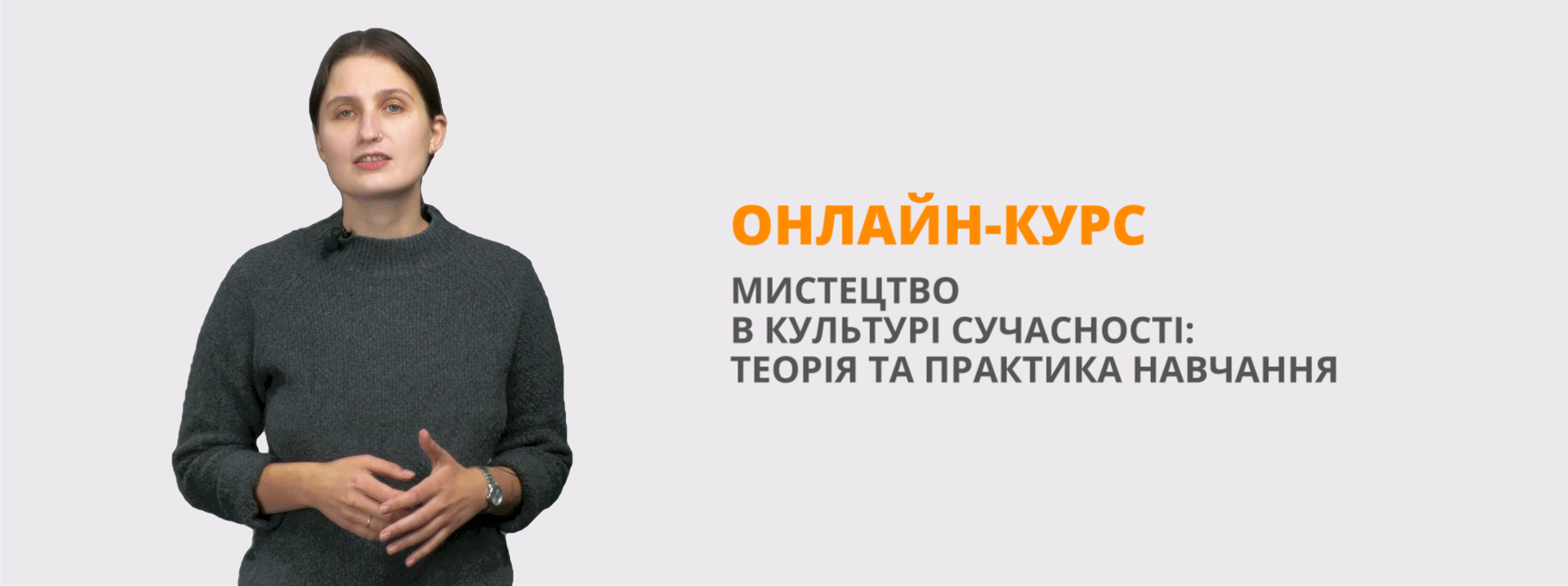Form 10. Lesson "The World of Painting in Ukraine"
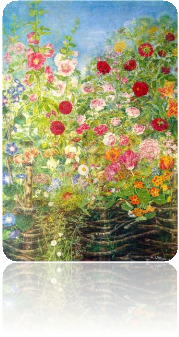

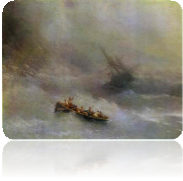
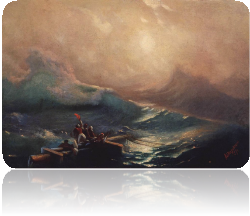
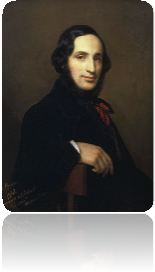 Ukrainian painters
Ukrainian painters
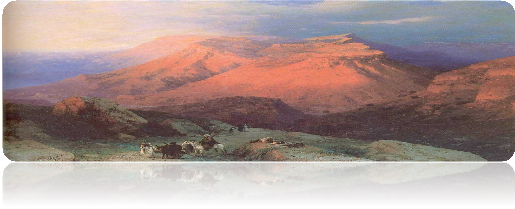
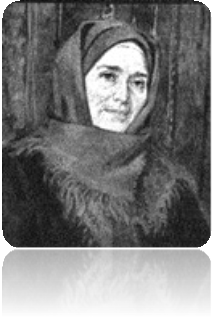
Осадча Юлія Олександрівна, учитель англійської мови
Краматорського НВК (ЗОШ № 32-ДНЗ).
Form 10
Lesson
The World of Painting in Ukraine
Objectives:
- to enrich students’ vocabulary on the topic;
- to develop students’ reading, listening and speaking skills;
- to provide student with additional information about famous Ukrainian painters;
- to consolidate the knowledge used in History and Arts lessons;
- to stimulate students’ creative thinking and imagination;
- to encourage group and pair work;
- to use new technologies in presenting the material on the topic ( the Internet, video, Power Point presentations, etc.)
Equipment: texts for group work, video, Power Point presentation.
Procedure
I Introduction
Today, we will learn interesting information about famous Ukrainian artists and pictures. We will do interesting and useful tests.We will practice our skills in describing pictures.Visual art is a vast subject, including all kinds of pictures and sculptures. Artists make art for many reasons. Hundreds of years ago – when many people couldn’t read – paintings were often designed to illustrate stories. And a lot of paintings were made to decorate churches. More recently, artists have begun to paint to express their own feelings or explore ideas, or just to create something beautiful. People have always argued about art – how to make it? What it should like and why. What kind of art you enjoy is up to you.
At our lesson we`ll try to find answers to the questions:
- What is art?
- What is painting?
- Why do people need art and painting?
II Warming up
What association do you have when you hear the word “art”? Let`s make such “Mind-Map”. (Створення “Mind-Map” на дошці і в зошитах.)
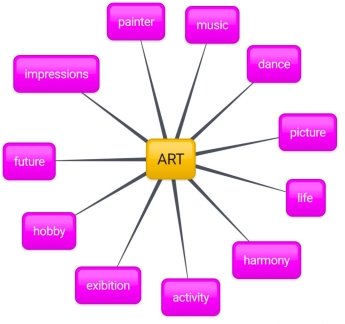
- Why do people need art? Write one idea in your copybooks.
(висловлювання учнів)
T: What is art for you?
P1. Art is maybe the most exciting part of our life. It reflects everything, people’s feelings, actions, souls, history, forms our moral values. Art makes us think about the sense of life, think how people must live, what ideal of beauty is.
T: What feelings can be evoked by arts?
- -generosity;
- happiness;
- sadness;
- jealousy;
- love;
- envy;
- -gratitude;
- fear;
- modesty;
- treachery;
- cowardice;
- hatred.
T: As the slogan of our lesson we’ll use the words of H. Longfellow
“Art is long and life is fleeting”.
How do you comment this saying?
P1: As for me I quite agree with this saying. No doubt person’s life is too short but the creations are powerful. Centuries will pass but the works created by these brilliant artists will live forever.
P2: I suppose art is living history of the past and it helps us understand the events of those times.
P3: I remember another saying “There is nothing but art. Art is living. I think it plays an important role in the development of mankind. Artists create masterpieces which give us the fullest and most vivid impressions.
P4: Art is expression of the culture and history. Art helps us to understand the culture and history of the native country and the foreign countries.
P5: Art lives. It forms our outlook and enriches our inner world. Art creates our notion of beauty and harmony. Art develops our good qualities.
P6: Art has a great educational significance. It brings people up – makes them more humane and kind.
T: Our lesson will be devoted to painting – the most understandable way of art, because it gives us the most full and vivid impressions. As Horacius said: “A picture is a poem without words.”
III Main Part
T: What types of pictures do you know?
- Possible answers: landscape, seascape, still life; historical pictures, allegorical pictures, icon, genre painting, scenes of daily life, battle scene, self-portrait, cityscape, etc.
still life historical painting
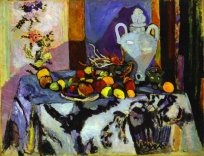
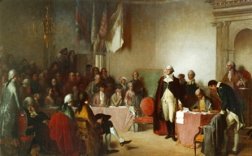
Landscape seascape

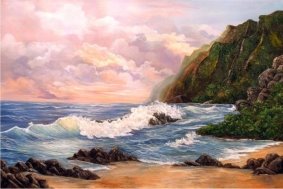
flower piece portrait
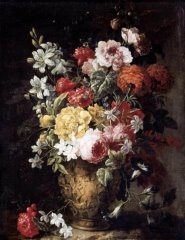
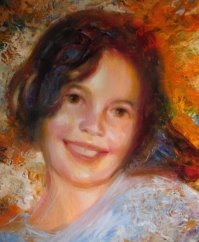
Painting is an important part of art and the oldest kind of art. It has been changing through the years and has existed in different forms and styles.
At our last lesson you have acquainted with different trends of art. Let`s revise them. What trends of art do you know?
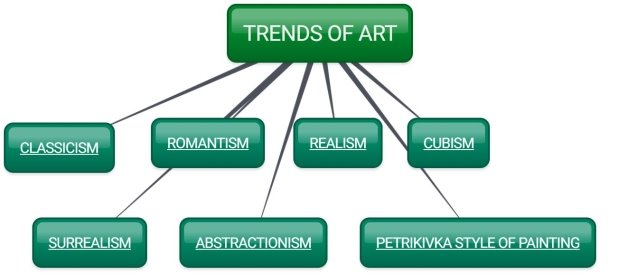
- Possible answers: Renaissance, Classicism, Romanticism, Realism, Impressionism, Post-Impressionism, etc.
T: Let us speak about these styles.
Styles of art
Renaissance
This epoch started in 14 and lasted until 17 century.
The Renaissance period in art history corresponds to the beginning of the great western age of discovery and exploration, when a general desire developed to examine all aspects of nature and the world. Art, during this period, became valued- not merely as a vehicle for religious and social identity, but even more as a mode of personal, aesthetic impression. During the Renaissance there were many drastic changes in the style of art. Early renaissance artists sought to create art forms consistent with the appearance of the natural world and with their experience of human personality and behavior, and artists studied the way light hits objects and the way our eyes perceive light. These artists made on effort to go beyond straightforward transcription of nature, to provide the work of art with ideal, intangible qualities, giving it a beauty and significance greater and more permanent than actually found in nature. A new kind of paint called oil paint was used. This allowed the artists to creature texture, mix colors.
Classicism – 17-18 centuries
It’s a style connected with classical culture and works of art, whose simplicity and severity of form contrast with the decorativeness of the baroque. Classicism came to Ukraine from central and southern Europe in the mid 18th century. It influence was felt first in Western Ukraine. The masters of decorating painting, which was very typical of the period and was widely used in the palaces in Ukraine, were Hryhorii Stetsenko, Kozakevych, Kosarevsky.
Romanticism or the Romantic Era - 18-19 centuries was a complex artistic, literary and intellectual movement that originated in the second half of the 18th century in Europe, and gained strength in reaction to the Industrial Revolution. In a revived clash between color and design, the expressiveness and mood of color, as in works of Turner, Francisco Goya, emphasized in the new prominence of the brushstroke and impasto the artist’s tree handling of paint. The art of Aivasovkiy was greatly influences by romanticism.
Realism followed Romanticism in the 19th century. Realistic paintings show things as they really are, as they appear to most people.
Impressionism is a style of painting used especially in the 19th century, which uses color instead of details to produce effect of lights or feelings. The leading exponents of Ukrainian impressionism were Oleksa Novakivsky, Olersandr Murashko, Vasyl Krychevsky, Mykola Hlushchenko, Oleksii Shovkunenko.
Surrealism appeared in the 20th century. In their works they used strange dreamlike images
Expressionism
At the beginning of the 20th century in Germany there developed a style known as Expressionism. Expressionist artists use exaggerated shapes and scenes to try convey feelings, as in the works of Edward Munch.
Abstract art became popular in the 20th century. It doesn’t mirror real people or things, but is a arrangement of shapes and colours.
IV. Project work (in groups)
T: You have told many interesting things about our Ukrainian artists and we have seen their beautiful pictures. Lets practice in describing of some pictures in our class exhibition. Every group must choose one of them and describe it. You may use the next slide as a hint.
How to describe a picture
- «The author of this picture is…» «The picture makes me feel happy/sad…»
- « My attention was captured by a woman who is….She is wearing…»
- «On the second plan of the picture we can see dogs/trees…. The dogs really makes this picture ……… funny…»
- «The boys are happy, because they…»
«They might be talking about…»
- «The picture made me think about… I think the artist tried to show us…»
«I recommend everybody to watch this picture, because it is…»
T: You have worked in groups and prepared projects about your favorite Ukrainian painters and pictures.
Which of the pictures do you like the best? Why?
What is the most striking thing about it?
What does it make you think of?
Group 1
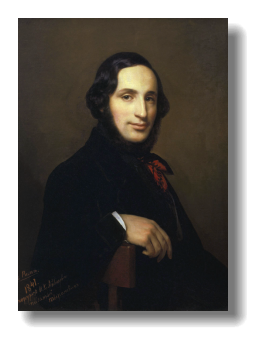
Ivan Aivazovskyi was born in the Crimea in the seaside city of Feodosia on July 17, 1817. The impressions of childhood determined his predilection for the seascape painting. In 1823 he entered the St. Petersburg Academy of Arts. In 1836 I. Aivazovskyi was introduced to O. Push kin as a greatly promising artist. He made 10 depictions of the great poet. The picture known most of all is “Pushkin Bidding Farewell to the Sea” executed by Aivazovskyi jointly with Illia Repin. It took I. A. only 4 years to finish the 6 year course of the Academy of Arts. He received a big gold medal and was granted a scholarship for training abroad. In Italy I. A. ranked with the best painters of Europe. The seascapes of the young painter appeared at the exhibitions in Rome, Paris, London and Amsterdam. They were highly appreciated by the viewers. In 1831 I. A. was awarded in France a gold medal. In Holland he was elected an Academician. It was a significant event since Holland is known to be the homeland of the seascape painting. I A. came back from abroad a recognized master. He was made Academician of St. Petersburg Academy. In 1845 the painter settled in Feodosia for good because of his deep affection for the Black Sea and his native city. He took the most active part in the city’s life. He created an art studio, opened a library and initiated the construction of the archeological museum. His tireless civil activities promoted the building of the seaport in Feodosia and the railway to it. I A. strove to make his house a center of artistic life. In 1880 to the house where he lived and worked a large hall was added where his paintings were exhibited. This hall became one of the first picture galleries in the country. The house had a small stage where amateur theatricals were arranged. The Gallery was visited by the townspeople and the passengers of the steamers calling at the Feodosia seaport. I. A. retained till the last day of his life the ability to create work without which he could not live. His words “To live means for me to work” could have become the motto of his life. Aivazovskyi died in the night on April 18, 1900. In 1900 according to I. Aivazovskyi’s will the Picture gallery became the property of the city of Feodosia.
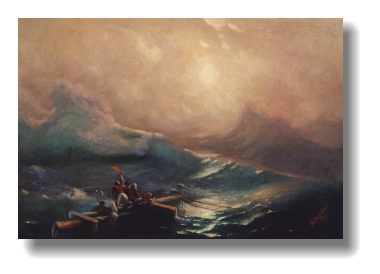
“The Ninth Wave” is one of the most famous paintings by I. A. He depicts the sea after the night storm and the strongest shipwreck. The sun’s rays illuminate the huge waves. The largest of them is the ninth wave, ready to attack the people trying to escape from the wreckage of the mast. The view speaks about the greatness and power of the waves and the helplessness of man in front of them. Warm colours make the sea not so harsh and give the viewer hope that people will be saved.
“The Ninth Wave“. An early dawn after a ninth storm, the first rays of light touch the surface of the raging ocean and the fearsome ninth wave is ready to crush a small group of people struggling for their lives among the wreckage. Although the situation seems desperate, the picture still leaves the viewer with glimmer of hope – it’s full of light from the rising sung that brings yet another day.
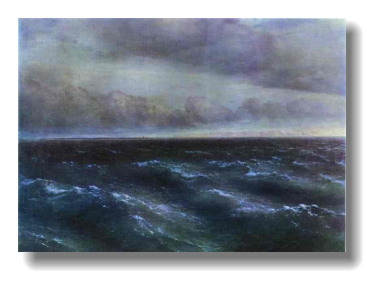
My favourite picture is “The Black Sea” by I.A. It’s the dark, grey, windy day. The sky is dragged with heavy clouds. The hang low over the sea space and it seems the sky is ready to compete and match themselves with sea elements. There are rush, picking up strength and power fast waves on the horizon. They move one after another and their dimensional rotation is provided throughout the special, stately way, saying that the sea is ready to take the call heaven. Such powerful forces will face in equal fight. The sky and the wave are ready to join in this battle. The stark simplicity and majestic beauty of the picture are created with fully consistent colours, based on a combination of warm grayish – purple sky the deep tones, and the greenish- blue colour of water. The artist uses subtle nuances of light and shade for a more accurate and natural marine transmission amplitude, movement of water and light.
“The Black Sea”
Aivazovsky’s talent took a new direction at the beginning of the 1870s. The somewhat sugary picturesqueness of his early works gave way to a more realist vision of the world. The romantic tension does not leave his pictures but takes on a sterner, more restrained character.
Aivazovsky’s greatest achievement in this period is The Black Sea (1881). Here the artist created a generalized imagine of the marine elements in their ever-changing manifestations. The distant horizon is calm, but towards the foreground the sea gets rougher and waves break the smooth surface of the water. In the immediate foreground the water forms great waves, created here and there by foam. Their measured rocking movement and the vastness of the sea are conveyed with exceptional power. So far the water has only begun to seethe, yet its motion is already relentless and frightening. The fine blue of the sky is being overtaken by a dense, grey wall of clouds; coloured shadows appear on the water with dappled patches and highlights – some blue, some turquoise or pure green – just as in reality. Ivan Kramskoy, who was a dis
cerning and sensitive critic, wrote of this picture; “ There is nothing in it but sky and water, yet the water is a boundless ocean, not rough, but restless, severe, infinite, and the sky is, if possible , more infinite still. It is one of the most powerful pictures I know”.
“Rainbow”
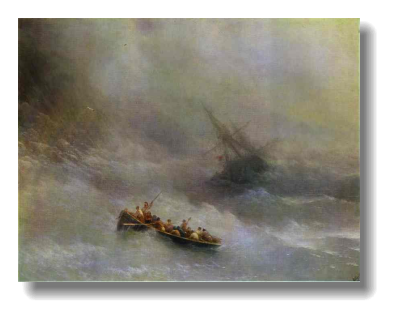
Aivazovsy painted over 6 thousand pictures during her long life. His picture “Rainbow” was created in 1873 and became a new stage in the artist’s creativity. On the first sight there is a typical for the artist depiction of “shipwreck’’. But then you see that this work is different from the other paintings. Not giving up his positions, especially when colouring the picture. The theme of the picture is the rain with a sinking ship at the seaside. Having depicted the storm, the author did it as if he himself was near. The wind is showing waters dust from the waves. You can hardly see the rocky seaside and silhouette of the sinking ship.The ship is getting down to the bottom slowly. The sailors are trying to escape in the boats. The front sailor is pointing to the way, where to sail. The people are exhausted from the struggle. They want to save their strength to change the waves. Looking at the picture , you can easily understand how deeply the artist felt nature in very detail.
Group 2
Illia Repin
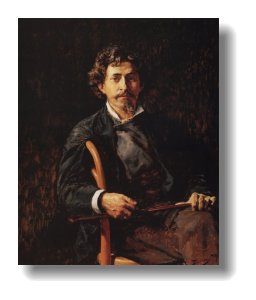
Ilia Repin was born on the 5th of August in 1844 in Chuhuiv, Zmiiv Country, Kharkiv gubernia and died on the 29th of September in 1930 in Finland. Repin, an outstanding painter, a full member of the St. Petersburg Academy of Arts from 1893, started his career under I. Kramskoi. He studied at the Academy of Arts (1864-1871), which granted him a scholarship to study in Italy and France. He joined the Peredvizhniki society in 1878 and the Mir Iskusstva group in 1890. For many years he lived in St. Petersburg and served as a professor (1894-1907) and the rector (1898-1899) of the Academy of Arts, where his students included the Ukrainian painters M. Pymonenko, O.Mureashko, F.Krasytsky and S. Prokhorov. Since 1900 Repin lived in Finland. A good part of his work consists of genre painting. Some of the works show his attachment to Ukraine, its people and history. Among them there is the famous painting “ The Zhaporozhian Cossaks Write a Letter to the Turkish sultan” (1880-1891), “Evening Party” (1881), “Haidamakys” (1898-1917), “Cossack in the Steppe” (1908) and “Hopak” (1926-1930), unfinished). He painted many portraits of Russian and Ukrainian cultural figures, including M. Kostomarov, I. Kramskoi, T. Shevchenko and D.Bahalii. He also did illustrations for editions of N. Gogol’s “Taras Bulba” (1872) and “Sorochinskaya yarmarka”(1882). He submitted four drawings in the competition for the design of the monument to Shevchenko in Kyiv (1910-1914). Repin sketched many Ukrainian landscapes and inhabitants. Although Repin was a realist, his rich colours and restless lines often produce an almost expressionistic effect. Some of his paintings show the influence of impressionism and symbolism.
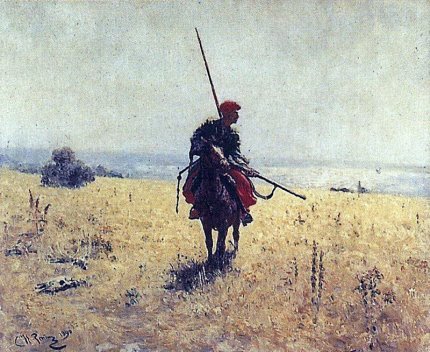
“Cossack in the Steppe”
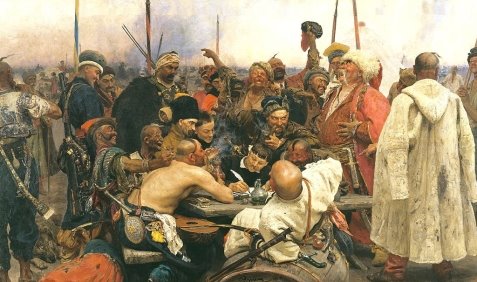
“The Zhaporozhian Cossaks Write a Letter to the Turkish sultan”
Mykola Pymonenko
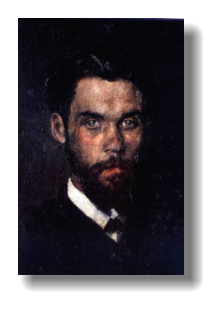
Mykola Pymonenko (1862-1912) a prominent Ukrainian realist painter was born in Kyiv in the family of an icon painter on March 9, 1862. He studied art in Kyiv, then in St. Petersburg Academy of Arts. In the 1890s, he joined the Travelling Artists’ Society (Peredvyzhnyky). He also taught in Kyiv Drawing and Art Schools. In 1909, he was elected a member of Paris International Association of Arts. Pymonenko produced over 700 genre scenes, landscapes, portraits devoted to the life of Ukrainian people. Many of them were reproduced as postcards. His pictures are exhibited in many Ukrainian Art galleries and museums now. Among the best known are “Wedding party in Kyiv Province”, “Fair”, “The girl with geese” and many others. His picture “Hopak” was bought by the Louvre. Pymonenko also created illustrations to several Taras Shevchenko’s narrative poems.

“Victim of fanaticism” is one of the most famous paintings of Ukrainian artist Mykola Pymonenko, written in 1899. The painting is made in oil on canvas. The young girl in a torn shirt, fleeing from an angry mob, clung to the fence around his neckcrisible cross. The girl’s parents are somewhat all of mother crying, turning away from her daughter, and her father raised his right hand in a gesture of renunciation of his daughter.
Group 3
Kateryna Bilokur

A century has passed since the birth of a great Ukrainian artist Kateryna Bilokur. Those hundred years comprised flashes of talents, successes and failures, victories and disappointments. She was born in a peasant family in 1900 in the village of Bohdanivka near Yahotyn. She did not have any education and had to study by herself. She literacy, read a lot and her soul craved for something unattainable. The great word ‘artist’ seemed to her so magic and beautiful. She said to herself that sooner or later she would become an artist. She kept repeating that life without art wasn’t possible for her. She had been very gifted in painting since her childhood. It was possibly the God’s providence that directed her hands, taught to discern colours and group the colour range. She began painting portraits of her relatives and villagers. In her later works Kateryna would extol a flower –the beauty of the land. Her paintings derived from the life-giving source of folk creativity based on songs, legends, tales and decorative arts. She admired the patterns on household utensils, Ukrainian clothes, towels, but her tender poetic soul was mostly charmed by flowers that blossomed around her house, in the gardens, meadows and fields. She called them ‘my children’ considering them human beings. Some pictures have her own captions: “Painted from nature by K. Bilokur”. She also called the flowers “the eyes of the Earth, the soul of the Earth”. Through them she comprehended nature and deepened her knowledge about it. She glorified flowers and said: “I’ll paint and paint flowers because I like to work on them so that I can’t find words to express my feelings to them, my great love for them. Kateryna Bilokur first exhibited her paintings in Poltava and Kyiv in 1940-1941. She was warmly welcome by her colleagues – Ukrainian artists and her way to recognition started. But the Great Patriotic War began and her 11 paintings were burnt in Poltava museum. She lived through hardships and difficulties of this war. The 1950s saw another raise in her artistic career. Her works were exhibited in Moscow and other cities. The public was charmed by her pictures “Peonies”, “Still life with bread”, “Breakfast”, “Flowers and Walnuts” and others. But a well-known painter Kateryna had lived all her life in pain and poverty; she did not have any family or children. The grave illness tortured her, besides she had to look after her sick mother. Great fame came later, after her death. The time has come to pay tribute: her works are exhibited in museums in Ukraine and abroad, a picture gallery bearing her name was open in Yahotyn, a street was named after her life and works are published in many languages. The Bilokur Prize Fund was founded for praising the most talented artists and painters.
The world of flowers served K. B. as a substitute for the warms of her home, her village, growing from a small petal to cosmic dimensions, to a universal phenomenon of beauty that permeated her tender soul. The harmony of colours reminded a rich carpet of verdure with prominent heads of flowers with bright petals that had grown on the rich Ukrainian land. In the refined composition” Flowers Behind the Wattle Fence” 1935, peonies, mallows, lilies with petals damp, with dew, pansies, daisies, morning glories and a multitude of other flower images appear before us in all their bright beauty, flowing in the transparent air, full of aromas and the strength of growth, deep rich colours and nuances. Harmony reigns in this Eden, there is a place for every flower, every grass, the smallest green leaf, and everything is permeated with thrilling essence of nature, crowned with comprehension of the perfection of earth.
“Early Spring”
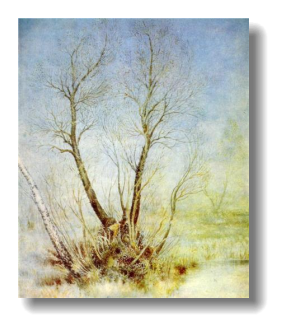
All the pictures by Kateryna Bilokur show her live to her native land. Her picture “Early Spring” impressed me very much. At first glance, there is nothing attractive in this landscape, but it is only at first glance. Looking attentively we can notice the simple beauty of the landscape as if you look through the open window. The space of the picture is symmetrically divided. In the foreground there are two young willows, and you have a feeling that you can touch with your finger. There is a birch nearby. It is clear that spring has come. We can see the first green grass. The nature awakens. The painter skillfully uses yellow-green, light blue, combining them with dark brown. The picture is painted in cold colours with helps as that winter meets spring. The colours contrast with each other. Spring mood breathes from the picture. This landscape makes us emotionally generous. The picture is romantic, lyrical and charming. The artist demonstrates a real talent as a colourist, she managed to capture the mood of the moment. The picture describes the joy of communication with mother-nature and makes us emotionally generous, humane. I think that only talented artist could create such a masterpiece.
“The Field Flowers”
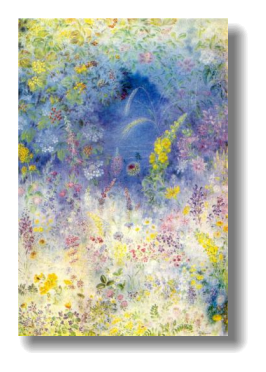
“The Field flowers’ is truly a remarkable picture by Kateryna Bilokur. It is indeed a masterpiece of Ukrainian painting. Looking at the picture, you can easily understand how deeply she saw and liked flowers in every detail. You look at the multi coloured flowers and feel a peace of mind. Besides a lot of butterflies are flying above them. This is really a poetic painting
1 Make up the sentences:
|
Tkachenko Levchenko Kulchitska Izhakevich Pimonenko |
was a brilliant, an outstanding, a prominent |
Portraitist |
Nature, landscape, seascape, genre, Still life, battle scenes |
|
painter of the |
2 Listening
AIVAZOVSKY PICTURE GALLERY
The picture gallery of Feodosia boasts the famous largest in the world collection of the most prominent painter of seascapes Ivan K. Aivazovsky. The Gallery in fact is the sole in Ukraine museum of the seascape painting. The Gallery was founded in 1880 by I. Aivazovsky. His life and creative carrer is reflected by the exhibition of the memorial- historical department.
Ivan K. Aivazovsky was born in Crimea in the seaside city of Feodosia on July 17, 1871. In 1833 he entered the St. Petersburg Academy of Arts. In 1836 Ivan Aivazovsky was introduced to A. Pushkin as a greatly promising artist. He made 10 depictions of the great poet. The picture known most of all is «Pushkin Bidding Farewell to the Sea» painted by Aivazovsky jointly with Illia Repin. It took Ivan Aivazovsky only four years to finish the six-year course of the Academy of Arts. He received a big gold medal and was granted a scholarship for training abroad.
The seascapes of the young painter appeared at the exhibitions in Rome, Paris, London and Amsterdam. Ivan Aivazovsky came back from abroad a recognized master. He was made Academician of St. Petersburg Academy. In 1845 the painter settled in Feodosia because of his deep affection for the Black Sea and his native city. He took the most active part in the life of the city. Ivan Aivazovsky wanted to make his house a center of artistic life. In 1880 to the house where he lived become one of the first picture galleries in the country. Ivan Aivazovsky worked till his last day. His words «To live means for me to work», could be his motto.
Aivazovsky died in the night on April 18, 1900, according to I.K. Aivazovsky’s will the Picture gallery became the property of the city of Feodosia. It numbered 49 pictures of the painter.
The romantic perception of the world was the nucleus of Aivazovsky’s talent. The painter strove to single out not the typical but the exclusive. He created pictures distinguished by a particular sonority and vividness of colours. The sea all glittering with sunlight, quiet moonlit nights are depicted in them with a great skill.
Among the works especially noteworthy are: «The St. George Monastery» /1846/, «Evening in Crimea Yalta» /1848/, «Venice» /1849/, «The seashore. Farewell» /1851/, «The Ships at the Roadstead» /1851/, «The Sea» /1853/, «The Moonlit Night in the Crimea» /1859/, «The Sea» /1864/, «A storm in the North Sea» /1866/.
The creation of these works was preceded by the spiritual atmosphere of Pushkin’s epoch. In his romantic works he expressed the idea of being happy only in «storms of battle». In 1858 the painter created his masterpiece «The Tenth Wave». It is considered the painter’s most romantic work. This large canvas is on show at the Russian Museum in St. Peterburg.
On the canvas amid the huge waves of the ocean the shipwrecked sailors trying to survive on the piece of the wreckage are depicted. The painter contrasts the will-power of a man with the violent force of the element. Filled with the pathos of the struggle it glorifies the courage of man before the smashing might of the raging ocean.
The secret of the popularity of the «Tenth Wave» lies not in the dramatism of the situation but in the general life-asserting mood of the picture. The struggle and triumph of man over the element is the painter’s favourite theme. The talent of I. Aivazovsky reached its height in the painting «Amid the Waves» created by the artist in 1898. The tendency for laconism of colour has been reflected in it. The beauty and might of the sea has been expressed in emotional colour range. The sea, the waves, the air are depicted with super skill. The emotional image of the sea is one of the masterpieces of world marine painting. The Feodosia Gallery boasts a large collection of Aivazovsky’s drawings /over 270/. Many of them can be regarded as independent works of art: «The Kerch Gulf with Schooners», «An Oriental town», «An Italian Town». Many people visit the famous picture gallery every year. Among the works of Aivazovsky there are a number of paintings, which have nothing in common with the marine subjects. The Ukrainian landscape pieces of Aivazovsky reveal great lyricism and keen perception of every day life. They attract one’s attention by a gentle poetical mood and beautiful sonorous coloring.
Post listening activities
- Choose the words from the box to complete the sentences.
|
seascapes |
Gallery |
The Tenth Wave |
Masterpiece |
Painting |
- The __________ was founded by I. Aivazovsky in 1880.
- In 1858 the painter created his _____________ «The Tenth Wave».
- The ____________ «Amid the Waves» was created in 1889.
- The famous seascape canvas of _______ is on show in the Russian Museum in St. Petersburg.
- I. Aivazovsky was the most prominent painter of ___________ .
Comprehension
- Say if it is True or False
- I. Aivazovsky was born in Armenia.
- According to his will the Gallery became the property of Feodosia.
- I. Aivazovsky didn’t paint portraits.
- The canvas «The Tenth Wave» is on show in the Aivazovsky Gallery.
- The painting «Amid the Waves» was created by the artists in 1889.
Discussion
- Answer the questions .
- Where was I.K. Aivazovsky born?
- Why did he settle in Feodosia?
- What are his masterpieces?
- Who helped Aivazovsky to paint the portrait of A.Pushkin?
- Where is the picture «The Tenth Wave» on show?
- What does the Ukrainian landscape pieces of Aivazovsky reveal?
4Translate the following sentences into your native language.
- In 1858 the painter created his masterpiece «The Tenth Wave».
- It is considered the painter’s most romantic work.
- This canvas is on show at the Russian Museum in St. Petersburg.
- On the canvas the shipwrecked sailors are depicted.
- The painter contrasts the man with the element.
- It glorifies the courage of man.
- The secret of «The Tenth Wave» lies in life-asserting mood.
5 Listening
T: Listen to the dialogue and be ready to do the task.
A: Oh, look, what a wonderful landscape!
B: No wonder it attracted your attention. Its Kulchtska’s «Children in the meadows». It is a real masterpiece.
A: Yes, she was fond of nature and often turned to nature for inspiration.
B: I should say, she had an instinctive feeling for nature.
A: The picture looks very realistic, you get an impression that you are in the meadow yourself.
B: You are right and I agree with you. Kulchitska is a famous for the simplicity and clarity of her artistic language.
Post listening: Fill the gaps and complete the following sentences.
a) to be fond of, b) to have an instinctive feeling, c) to be famous for,
d) to look very, e) to get an impression, f) wonderful.
1. O. Kulchitska___of nature.
2. This picture _______very realistic, doesn’t it?
3. This painter ________the simplicity and clarity of his artistic language.
4. Look! What a________ landscape!
5. You ______that you are in this meadow yourself.
6. Kulchitska is a______ painter of landscape.
Keys: 1-a; 2-d; 3-b; 4-f; 5-e; 6-c.
- Grammar revision
T: Let’s revise the usage of relative clause.
P: Relative pronouns (who, which, that, where, whose) introduce relative clauses. Relative clauses identify the thing or person we are talking about: without relative clause, it might not be clear what or who we are talking about.
People: who, whose, that
Places: where, that
Things: which, whose, that
Read the sentences and fill in the gaps with relative pronouns: who, which, that, where, whose.
- I suppose I’m not a great art lover. 2. I like posters ……. look good in my bedroom. 3. I usually buy posters ……. I find in my stores. 4. I like buying pictures ……. go well with my mood. 5. Sometimes, I go to art galleries ……. I buy copies of famous paintings. 6. I prefer pictures ……. are realistic.7. Some people ……. I know spend lots of money on paintings ……. are really expensive and ……. look horrible. 8. I have a friend ……. collection of modern art is very valuable.9. The paintings …… he buys are perhaps more sophisticated than mine but I’m happy with my collection.
Key: 2) that; 3) which; 4) that; 5) where; 6) that; 7) who, which, that; 8) whose; 9) which.
V Summing up
Summing up the lesson I want to add that art and nation are inseparable. Artists are inspired by national culture, but their works are able to make the entire world speaking about this nation. And I’m proud of being living in Ukraine, where were born so much outstanding artists.
Dear children, you have coped with the tasks very well. All of you were well-prepared and active. I enjoy your work at the lesson. And I am sure you have had good practice. In edition I want to tell I believe that our young generation will be positive, will be respectful and responsible and we will proud of you. We must proud of our Ukrainian artists, scientists, politics, teachers etc. Let’s be patriots of our Motherland. L
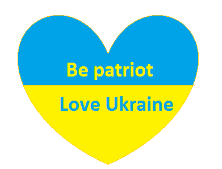
VI Home Assignment
Imagine that you are a painter. What picture would you like to paint? Describe it.


про публікацію авторської розробки
Додати розробку
